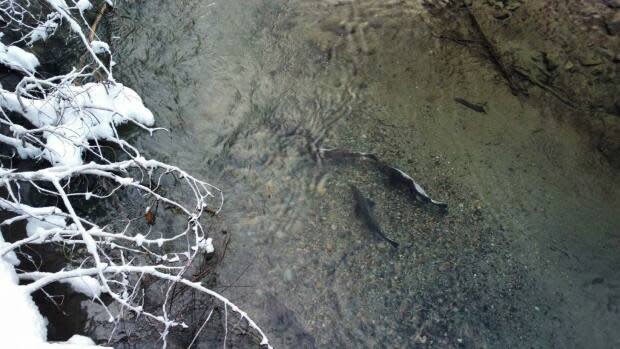Thousands of salmon return to spawning grounds after channel dug around Coldwater River logjam

One year after the floods of November 2021 left coho salmon stranded behind a logjam in the Coldwater River, recovery efforts have cleared the way for 2,000 of the fish to swim upstream to their spawning grounds.
The Coldwater, one of B.C.'s most important salmon rivers, was blocked when the floods threw logs and sediment across the waterway, barring access to over 10 kilometres of important habitat.
The area around the logjam, located southwest of Merritt in B.C.'s Thompson-Nicola region, has been surveyed over the past year to determine how salmon were being affected.
Last month, the Nicola Fisheries Emergency Working Group observed that thousands of coho salmon were getting stuck downstream of the logjam.

"Logjams are natural and most of the time salmon are able to find their way around them," said Jason Hwang, vice president of the Pacific Salmon Foundation, which is part of the working group.
But Hwang says around Remembrance Day, an overflight observed somewhere between 1,500 and 2,000 coho in the immediate vicinity downstream of the logjam, indicating that they were stuck there and not able to get past.
The discovery prompted quick action, says Hwang, and crews from Fisheries and Oceans Canada were deployed to clear a small channel into the sediment built up around the logjam so salmon could travel upstream.
Hwang says diverting the salmon around the logs was the best course of action.
"What you don't want to do is do something that's going to destabilize the river system even more."
As soon as the way was cleared, Hwang says they observed salmon swimming upriver, and about six days later, an overhead flight observed 1,500 to 2,000 coho in the high-quality spawning habitat on the other side of the logjam.
"They'll be able to spawn very successfully there," he explained. "That will mean the eggs will be able to have high survival. That means there will be lots of juveniles."
"Even in all of the devastation in the Coldwater River from the floods, we think that the coho that came back this year, that were given access to that really good habitat, will have really high survival," said Hwang.
The foundation provided approximately $50,000 in funding for the assessment, project plan and construction work to free the fish.
Hwang says the work was a collaboration with other members of the working group, including Fisheries and Oceans Canada (DFO) and the Scw'exmx Tribal Council.


